
Hãy nhập câu hỏi của bạn vào đây, nếu là tài khoản VIP, bạn sẽ được ưu tiên trả lời.


11:
a: \(BD=AC=\sqrt{\left(3a\right)^2+\left(4a\right)^2}=5a\)
|vecto AB+vecto AD|
=|vecto AB+vecto BC|
=|vecto AC|
=5a
b: Gọi M là trung điểm của BC
=>BM=CM=BC/2=2a
\(AM=\sqrt{AB^2+BM^2}=a\sqrt{13}\)
Xét ΔABC có AM là trung tuyến
nên vecto AB+vecto AC=2*vecto AM
=>|vecto AB+vecto AC|=2|vecto AM|
=>\(\left|\overrightarrow{AB}+\overrightarrow{AC}\right|=2\cdot AM=2a\sqrt{13}\)

a: \(\overrightarrow{AB}=\left(-4;3\right)AC;=\left(-2;0\right)\)
Vì -2/-4<>0/3
nên A,B,C không thẳng hàng
=>A,B,C là ba đỉnh của một tam giác
b: A là trung điểm của EC
=>\(\left\{{}\begin{matrix}x_E+1=2\cdot3=6\\y_E-1=2\cdot\left(-1\right)=-2\end{matrix}\right.\Leftrightarrow E\left(5;-1\right)\)
c: A là trọng tâm của tam giác BCG
=>\(\left\{{}\begin{matrix}-1+1+x_G=3\cdot3=9\\2-1+y_G=3\cdot\left(-1\right)=-3\end{matrix}\right.\Leftrightarrow G\left(9;-4\right)\)
d: ADBC là hình bình hành
=>vecto AD=vecto CB
vecto CB=(-2;3)
vecto AD=(x-3;y+1)
Do đó, ta có:
x-3=-2 và y+1=3
=>x=1 và y=2
=>D(1;2)
f: Tọa độ H là;
\(\left\{{}\begin{matrix}x=\dfrac{3-1+1}{3}=1\\y=\dfrac{-1+2-1}{3}=0\end{matrix}\right.\)

22:
a:
\(\overrightarrow{AD}=2\overrightarrow{DB}\)
=>\(\overrightarrow{AD}=\dfrac{2}{3}\overrightarrow{AB}\)
\(\overrightarrow{CE}=3\overrightarrow{EA}\)
=>\(\overrightarrow{AE}=\dfrac{1}{3}\overrightarrow{EC}\)
=>\(\overrightarrow{AE}=\dfrac{1}{4}\overrightarrow{AC}\)
Xét ΔAED có AM là trung tuyến
nên \(\overrightarrow{AM}=\dfrac{1}{2}\left(\overrightarrow{AD}+\overrightarrow{AE}\right)\)
\(=\dfrac{1}{2}\left(\dfrac{2}{3}\overrightarrow{AB}+\dfrac{1}{4}\overrightarrow{AC}\right)=\dfrac{1}{3}\overrightarrow{AB}+\dfrac{1}{8}\overrightarrow{AC}\)
b: \(\overrightarrow{MI}=\overrightarrow{ME}+\overrightarrow{EI}\)
\(=\dfrac{1}{2}\overrightarrow{DE}+\overrightarrow{EC}+\overrightarrow{CI}\)
\(=\dfrac{1}{2}\left(\overrightarrow{DA}+\overrightarrow{AE}\right)+\dfrac{3}{4}\overrightarrow{AC}+\dfrac{1}{2}\overrightarrow{CB}\)
\(=\dfrac{1}{2}\left(-\dfrac{2}{3}\overrightarrow{AB}+\dfrac{1}{4}\overrightarrow{AC}\right)+\dfrac{3}{4}\overrightarrow{AC}+\dfrac{1}{2}\overrightarrow{CA}+\dfrac{1}{2}\overrightarrow{AB}\)
\(=\dfrac{-1}{3}\overrightarrow{AB}+\dfrac{1}{8}\overrightarrow{AC}+\dfrac{3}{4}\overrightarrow{AC}-\dfrac{1}{2}\overrightarrow{AC}+\dfrac{1}{2}\overrightarrow{AB}\)
\(=\dfrac{1}{6}\overrightarrow{AB}+\dfrac{3}{8}\overrightarrow{AC}\)


Giả sử đường thẳng chắn trên hai trục tọa độ 2 đoạn bằng nhau bằng a \(\left(a\ne0\right)\)
Khi đó, tọa độ giao điểm là: (a;0), (0;a)
Phương trình đường thẳng là: \(\dfrac{x-a}{a-0}=\dfrac{y-0}{0-a}\Leftrightarrow-a\left(x-a\right)=ay\)
\(\Leftrightarrow-x+a=y\) (*)
a. Thay M(-4;10) vào (*) ta được: \(-\left(-4\right)+a=10\Rightarrow a=6\)
Phương trình đường thẳng cần tìm là: y=-x+6
b. Thay M(2;1) vào (*) ta được: \(-2+a=1\Rightarrow a=3\)
Phương trình đường thẳng cần tìm là: y=-x+3


Câu 5:
\(\overrightarrow{AM}=\overrightarrow{AB}+\overrightarrow{BM}\)
\(=\overrightarrow{AB}+\dfrac{2}{3}\overrightarrow{BC}\)
\(=\overrightarrow{AB}-\dfrac{2}{3}\overrightarrow{AB}+\dfrac{2}{3}\overrightarrow{AC}\)
\(=\dfrac{1}{3}\overrightarrow{AB}+\dfrac{2}{3}\overrightarrow{AC}\)
\(c5\) \(\overrightarrow{AM}=\overrightarrow{AB}+\overrightarrow{BM}=\overrightarrow{AB}+\dfrac{2}{3}\overrightarrow{BC}\)
\(=\overrightarrow{AB}+\dfrac{2}{3}\left(\overrightarrow{BA}+\overrightarrow{AC}\right)=\overrightarrow{AB}-\dfrac{2}{3}\overrightarrow{AB}+\dfrac{2}{3}\overrightarrow{AC}\)
\(=\dfrac{1}{3}\overrightarrow{AB}+\dfrac{2}{3}\overrightarrow{AC}\left(đpcm\right)\)
\(c4:\Rightarrow\overrightarrow{GA}+\overrightarrow{GB}+\overrightarrow{GC}=\overrightarrow{GG'}\)
\(\overrightarrow{G'A'}+\overrightarrow{G'B'}+\overrightarrow{G'C'}=\overrightarrow{GG'}\)\(\Leftrightarrow\overrightarrow{G'A}+\overrightarrow{AA'}+\overrightarrow{G'B}+\overrightarrow{B'B}+\overrightarrow{G'C}+\overrightarrow{CC'}=\overrightarrow{GG'}\)
\(\Leftrightarrow\overrightarrow{AA'}+\overrightarrow{BB'}+\overrightarrow{CC'}=3\overrightarrow{GG'}\)\(\left(dpcm\right)\)
\(c3:a,\) \(2\overrightarrow{IA}+\overrightarrow{IB}+\overrightarrow{IC}=2\overrightarrow{IA}+2\overrightarrow{IM}=2\overrightarrow{MI}+2\left(\overrightarrow{IM}+\overrightarrow{MI}\right)=2.\overrightarrow{0}=\overrightarrow{0}\left(đpcm\right)\)
\(b,2\overrightarrow{OA}+\overrightarrow{OB}+\overrightarrow{OC}\)
\(=2\left(\overrightarrow{OI}+\overrightarrow{IA}\right)+\overrightarrow{OI}+\overrightarrow{IB}+\overrightarrow{OI}+\overrightarrow{IC}\)
\(=4\overrightarrow{OI}+2\overrightarrow{IA}+\overrightarrow{IB}+\overrightarrow{IC}\)\(=4\overrightarrow{OI}+\overrightarrow{0}=4\overrightarrow{OI}\left(đpcm\right)\)
\(c2:\) \(\left\{{}\begin{matrix}3AH=2AB\\3AK=AC\\4BM=3MC\\\end{matrix}\right.\)\(\Leftrightarrow\left\{{}\begin{matrix}\overrightarrow{AB}=\dfrac{3}{2}\overrightarrow{AH}\\\overrightarrow{AC}=3\overrightarrow{AK}\\\overrightarrow{BM}=\dfrac{3}{7}\overrightarrow{BC}\Rightarrow\overrightarrow{BC}=\dfrac{7}{3}\overrightarrow{BM}\end{matrix}\right.\)
\(\Rightarrow\overrightarrow{BC}=\overrightarrow{AC}-\overrightarrow{AB}=3\overrightarrow{AK}-\dfrac{3}{2}\overrightarrow{AH}\)
\(\Rightarrow\dfrac{7}{3}\overrightarrow{BM}=3\overrightarrow{AK}-\dfrac{3}{2}\overrightarrow{AH}\Leftrightarrow\overrightarrow{BM}=\dfrac{9}{7}\overrightarrow{AK}-\dfrac{9}{14}\overrightarrow{AH}\)
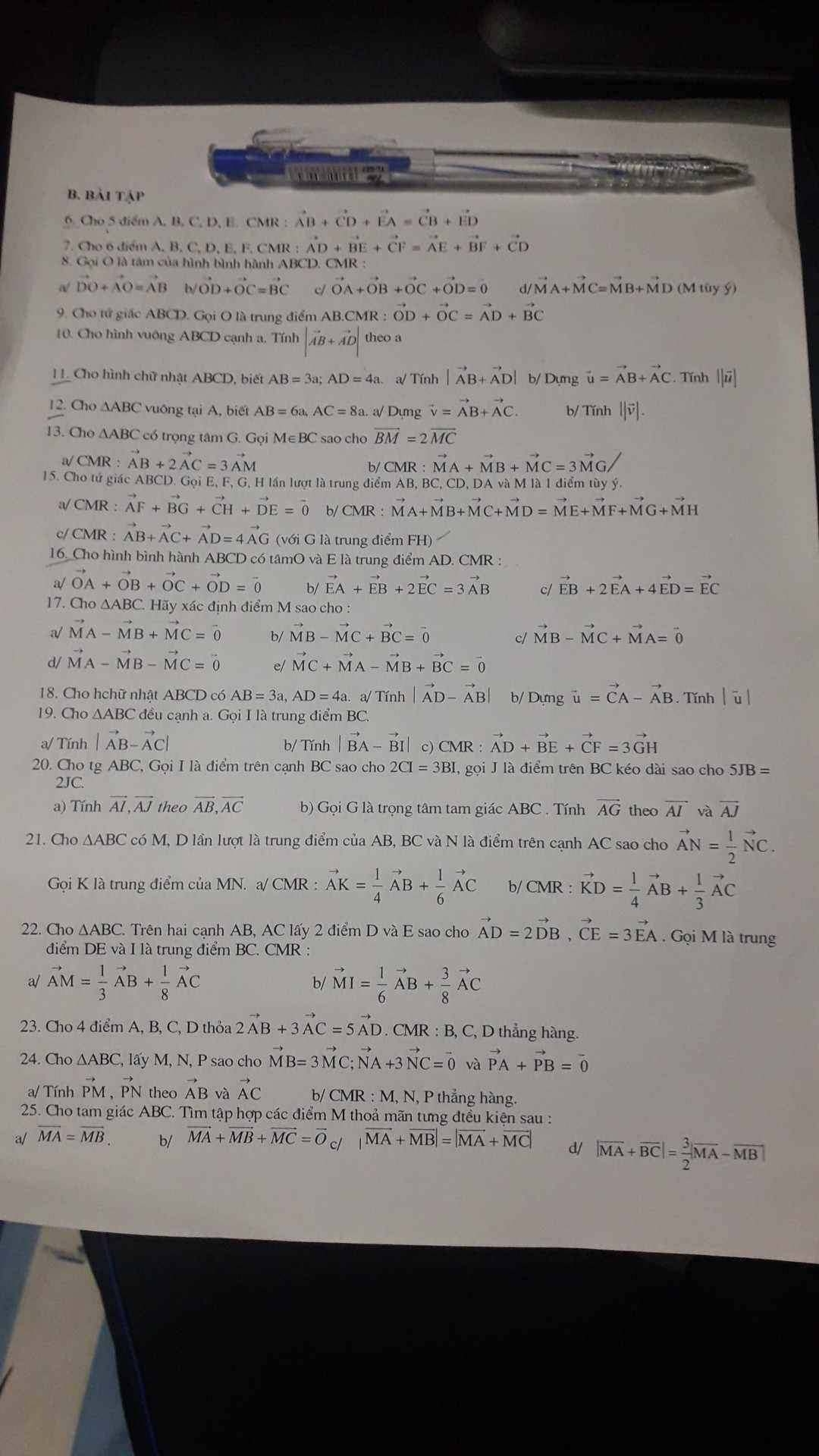
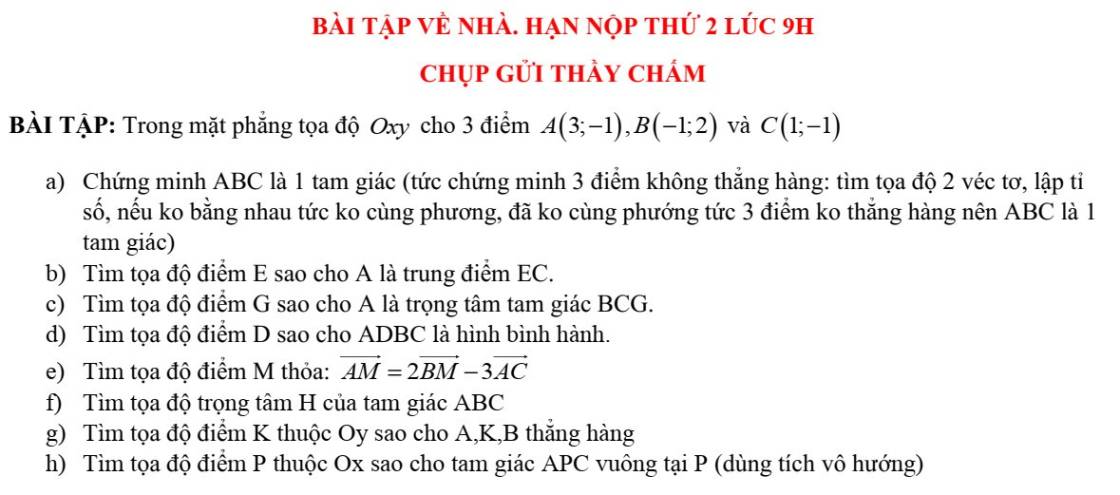
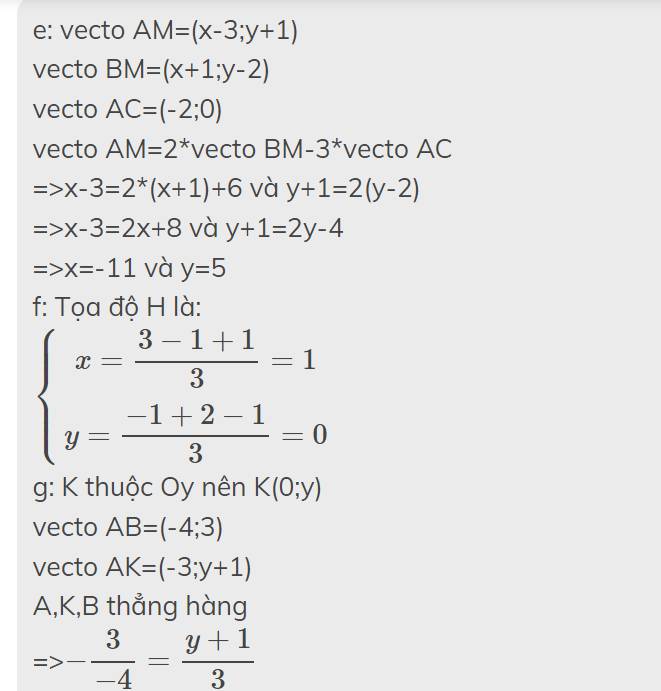
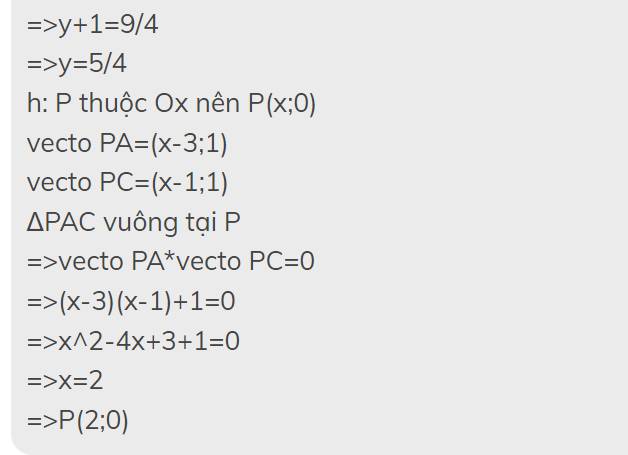
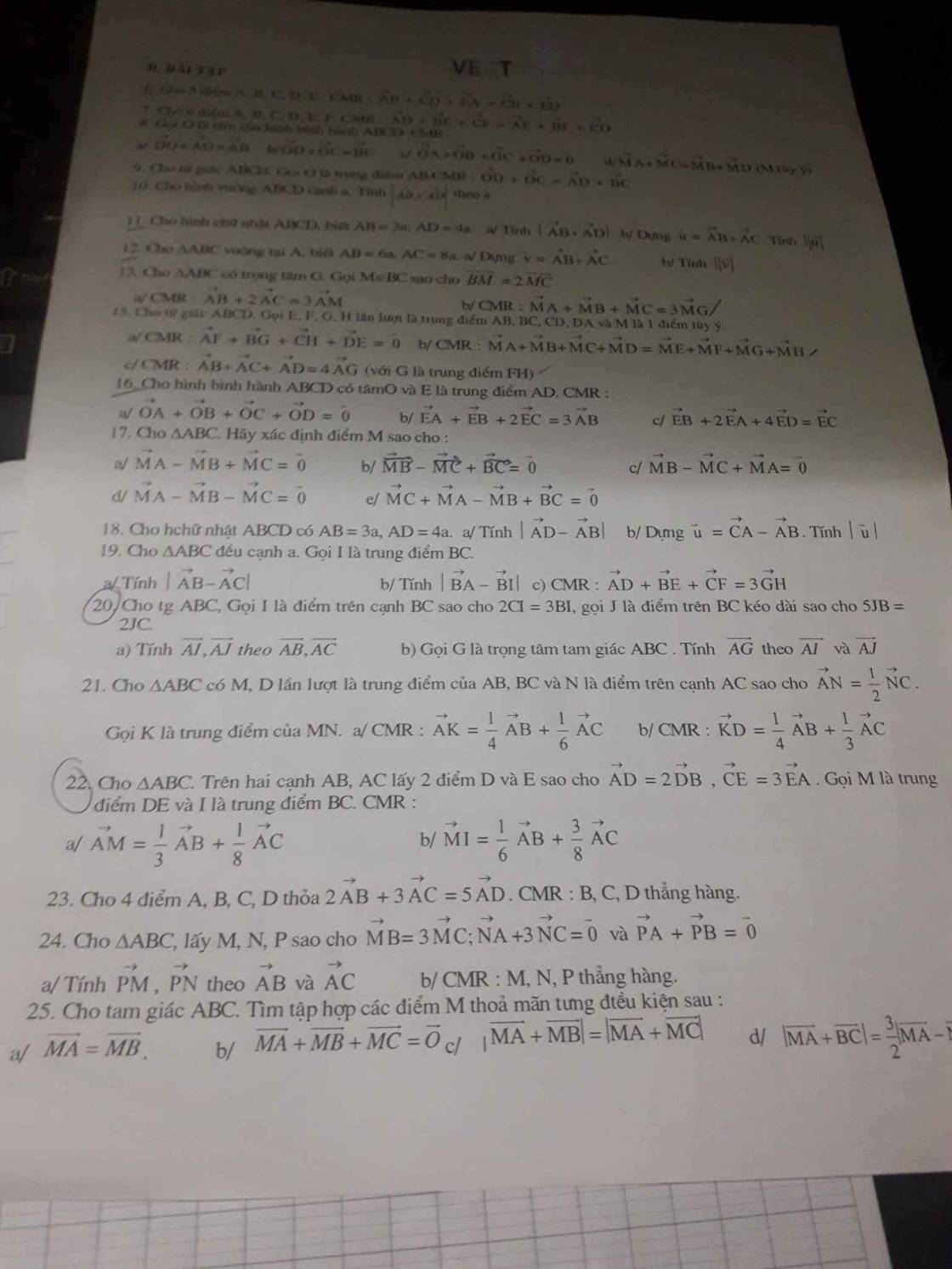



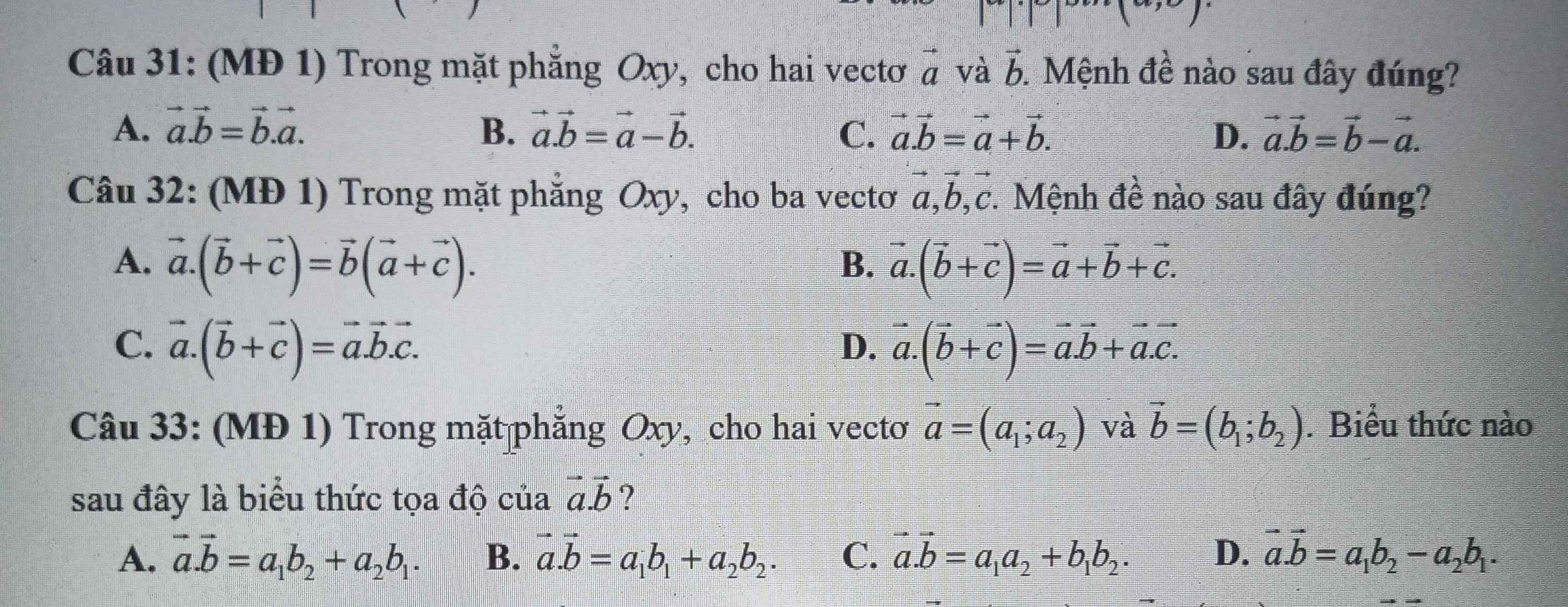


12:
a: Gọi M là trung điểm của BC
trên tia đối của tia MA, lấy D sao cho M là trung điểm của AD
Xét tứ giác ABDC có
M là trung điểm chung của AD và BC
góc BAC=90 độ
=>ABDC là hình chữ nhật
=>\(\overrightarrow{AB}+\overrightarrow{AC}=\overrightarrow{AD}\)
=>\(\overrightarrow{v}=\overrightarrow{AD}\)
b: \(\left|\overrightarrow{v}\right|=\left|\overrightarrow{AD}\right|=AD=2\cdot AM=2\cdot\dfrac{BC}{2}=BC=\sqrt{\left(6a\right)^2+\left(8a\right)^2}=10a\)
hình như đó đâu phải là câu 12 đâu ạ 🤔🤔🤔 trong đề câu 12 có chi tiết nào liên quan tới M đâu 🤔